Japanese anti-aircraft missile systems of the Cold War era
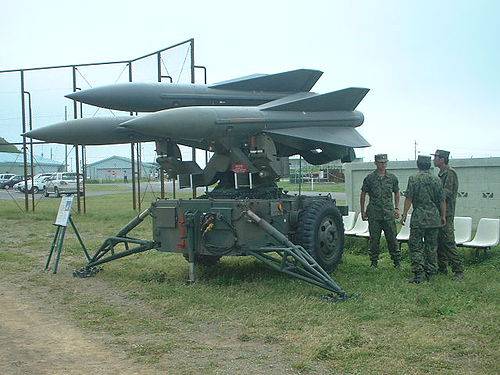
In parallel with the creation of the Air Self-Defense Forces, the systematic development of the ground component of the Japanese air defense system began in the late 1950s. In addition to a network of radar posts and an automated control system, it included medium and long-range anti-aircraft missile systems that protected strategically important civilian objects and large military bases from air strikes. In the 1980s, the ground forces received Japanese-made short-range mobile anti-aircraft missile systems and American portable anti-aircraft missile systems, and shortly before the end of the Cold War - the PAC-2 Patriot long-range air defense system.
Anti-aircraft missile system MIM-3A Nike Ajax
The MIM-3 Nike Ajax anti-aircraft missile system, successfully tested in 1953, was the first air defense system adopted by the American army. Although "Nike-Ajax" had a number of significant shortcomings, this air defense system was massively deployed in the United States and supplied to the closest allies. Serial production of "Nike-Ajax" was carried out until 1958. During this time, the manufacturer Douglas Aircraft delivered 110 systems and more than 13000 anti-aircraft missiles.
This complex was purely stationary, and when it was deployed in the United States, as a rule, the construction of well-equipped positions, buildings and capital structures was carried out. The central control center of the complex was usually located in a protected bunker, in which control and communication equipment, as well as calculating devices, were mounted. Not far from the control room were bulky radars for detection and guidance. The technical position had storage facilities for missiles, tanks with rocket fuel and oxidizer, and 4–6 launchers.
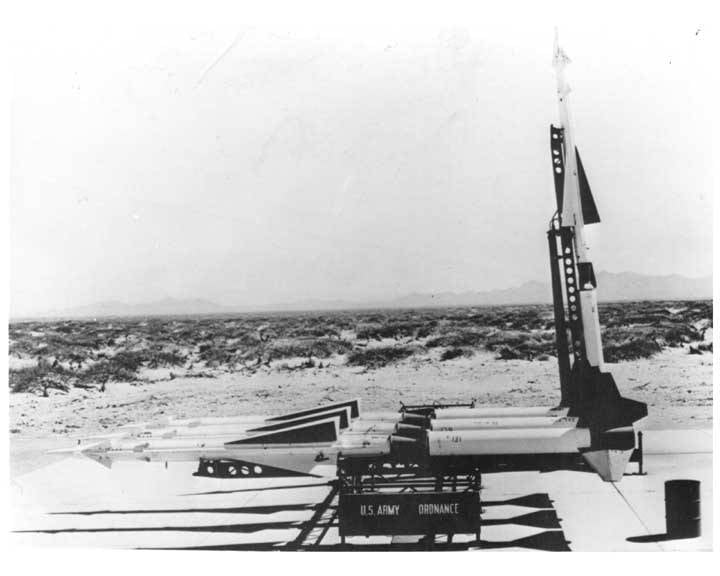
Launch position of SAM MIM-3A
The anti-aircraft missile of the first American mass-produced air defense system used a sustainer engine running on liquid fuel and an oxidizer. The launch took place using a detachable solid-propellant booster. Targeting - radio command.
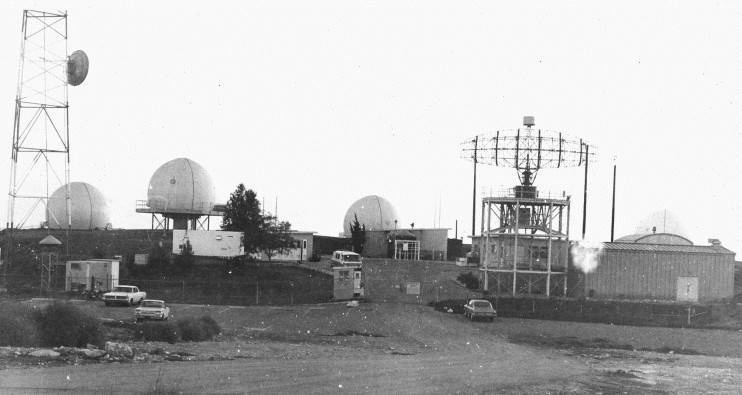
MIM-3A air defense missile system detection and guidance radars
The data supplied by the radars were processed by a calculating device built on electrovacuum devices. The device calculated the calculated meeting point of the missile and the target and automatically corrected the missile's course. Undermining the warhead of the missile defense system was carried out by a radio signal from the ground at the calculated point of the trajectory.
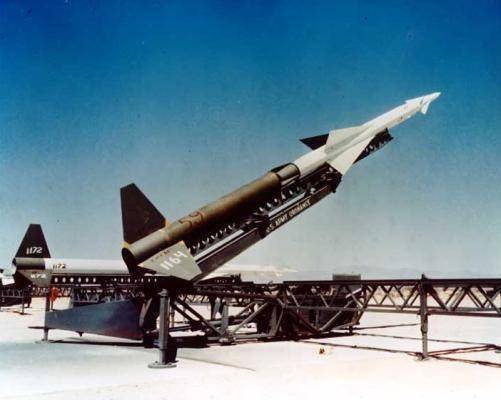
SAM MIM-3A Nike Ajax on the launcher
A unique feature of the Nike-Ajax anti-aircraft missile was the presence of three high-explosive fragmentation warheads. The first (weighing 5,44 kg) was located in the bow section, the second (81,2 kg) - in the middle, and the third (55,3 kg) - in the tail section. It was assumed that the use of several warheads would increase the likelihood of hitting a target due to a more extended cloud of debris.
The mass of the equipped rocket was 1120 kg. Length - 9,96 m. Maximum diameter - 410 mm. The maximum firing range is 48 kilometers. The rocket, having accelerated to 750 m / s, could reach a target flying at an altitude of 21 km.
For the mid-1950s, the Nike-Ajax air defense system had good characteristics and could be quite effective against long-range bombers. However, the process of refueling anti-aircraft missiles with fuel and oxidizer was very time consuming and dangerous. After working with the rockets, the spacesuits had to be treated with a special solution and the components of the jet fuel were washed off from them.
When preparing the missile defense system for combat duty, the technical personnel had to use insulating spacesuits. Fuel and oxidizer leaks could lead to fire, explosion and poisoning. Technical malfunctions of missiles and equipment have caused a number of incidents in which people have died.
All this became the reason that the American army, by 1964, removed from service all the MIM-3 Nike Ajax air defense systems, replacing them with the MIM-14 Nike-Hercules complexes, which used anti-aircraft missiles with a solid-fuel engine. Some of the anti-aircraft systems removed from service by the US army were not disposed of, but supplied to the allies: Greece, Italy, Holland, Germany, Turkey and Japan. In some countries, they were used until the early 1970s.
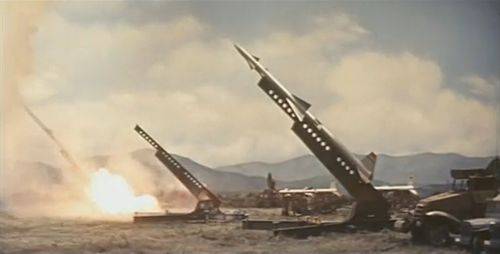
In 1963, the United States donated four batteries of the MIM-3A Nike Ajax air defense system to Japan, 6 launchers and 80 anti-aircraft missiles each. According to Japanese sources, the Nike-Ajax complexes located in Saitama prefecture on the island. Honshu were on combat duty until 1973.
Initially, the Nike-Ajax air defense system entered the disposal of the Ground Self-Defense Forces, but in 1965, after the development of the low-altitude air defense system MIM-23A Hawk, they were transferred to the Air Self-Defense Forces.
Unlike the United States, Japan did not pay such attention to equipping the positions of anti-aircraft missile batteries, and all the equipment of the complex was located in pre-fabricated buildings and containers.
Anti-aircraft missile system MIM-14 Nike-Hercules
In the mid-1950s, formulations of an effective solid fuel suitable for use in long-range anti-aircraft missiles were created in the United States. This, in turn, made it possible to develop a new air defense system with solid-propellant missiles, which used the Nike Ajax MIM-3A air defense missile guidance system.
Compared to the anti-aircraft missile of the MIM-3A complex, the new solid-propellant missile defense system has become much larger and heavier. The mass of the fully equipped rocket was 4860 kg, the length was 12 m. The maximum diameter of the first stage was 800 mm, the second stage was 530 mm. The wingspan of 2,3 m. The defeat of the air target was carried out by detonating a proximity fuse with a powerful high-explosive fragmentation warhead, weighing 502 kg, containing 270 kg of explosives. The maximum rocket speed was 1150 m / s.
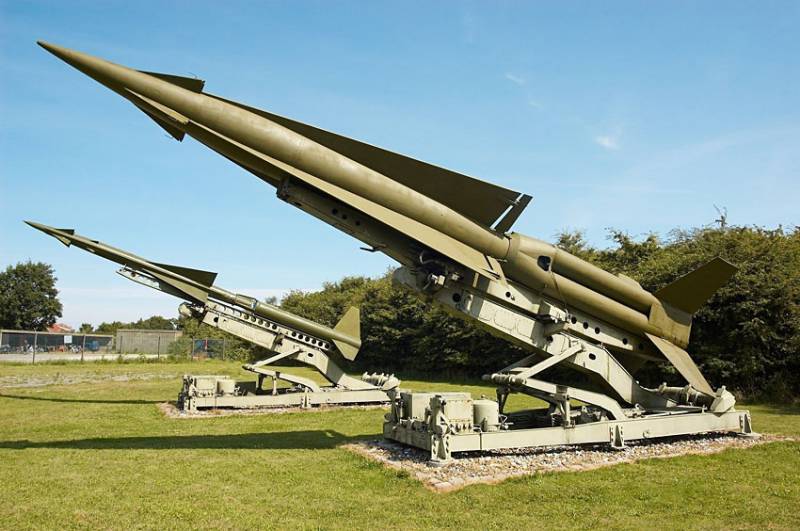
SAM MIM-14 (foreground) and SAM MIM-3A
The complex, which later received the designation MIM-14 Nike Hercules, entered service with the US Army in 1958 and was built in large series. In total, 1960 Nike-Hercules batteries had been deployed in the United States by the mid-145s (35 rebuilt and 110 re-equipped from Nike Ajax batteries). In the United States, the release of the Nike-Hercules air defense system continued until 1965, they were in service in 11 countries in Europe and Asia. In addition to the United States, licensed production of the MIM-14 Nike Hercules air defense system was carried out in Japan. A total of 393 batteries and about 25000 anti-aircraft missiles were built.
Compared to Nike-Ajax, solid-propellant missiles of the Nike-Hercules air defense system have become much easier and safer to maintain. The firing range of the latest versions of the MIM-14 SAM was brought up to 150 km, with a maximum altitude reach of 30 km, which is a very good indicator for a solid-propellant rocket created in the 1960s. At the same time, long-range firing could only be effective when using a nuclear warhead.
So, when firing one missile equipped with a conventional warhead, at a non-maneuvering target of the Il-28 type, flying at an altitude of 8 km at a speed of 720 km / h at a distance of 70 km, the probability of destruction did not exceed 0,6. At a greater distance, "Nike-Hercules" was able to fight such large and low-maneuverable aircraft as Tu-16 and Tu-95. With an increase in the firing range, the radio command guidance scheme gave a large error, which was also aggravated by a single-channel guidance system. Also, the capabilities of the complex to defeat low-flying targets were insufficient. The minimum range and height of hitting a target flying at speeds up to 800 m / s were 13 and 1,5 km, respectively.
The Nike-Hercules detection and guidance system was originally based on a stationary detection radar from the Nike-Ajax air defense missile system, operating in continuous radiation mode. The system had a means of identifying the nationality of air targets, as well as target designation means.
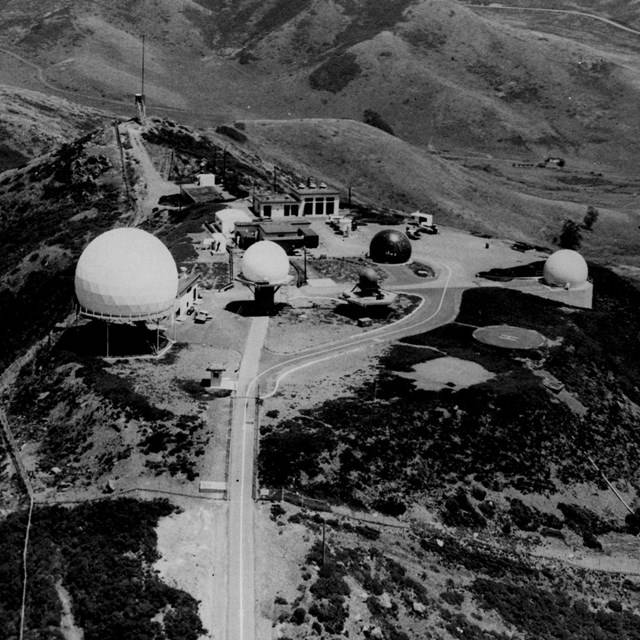
Stationary SAM MIM-14 Nike Hercules radar systems
Soon after the adoption of the stationary version of the deployment of the complex ceased to suit the military, and they demanded to improve the noise immunity of the guidance system. In 1960, a modification of the Improved Hercules - "Improved Hercules" was presented for testing. The upgraded Improved Hercules (MIM-14V) air defense system has introduced new detection radars and improved tracking radars, which has increased the noise immunity and the ability to track high-speed targets.
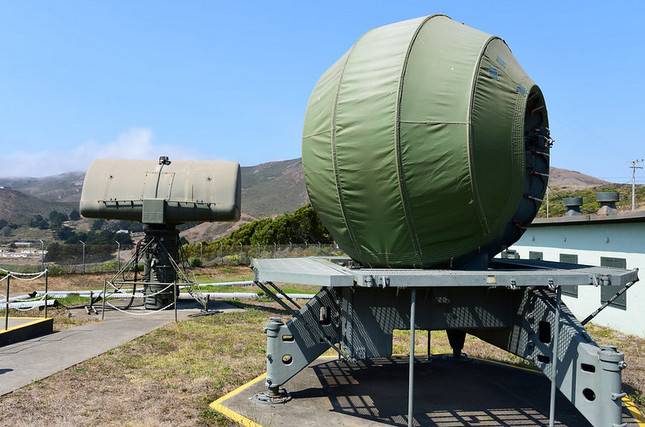
Radar SAM MIM-14V
The use of an additional radio range finder made it possible to continuously determine the distance to the target and issue additional corrections for the calculating device. On the MIM-14C modification, a significant part of the element base was transferred to solid-state electronics, which increased reliability, reduced dimensions, and power consumption of the hardware. The modernized air defense system could already be relocated to a new position within a reasonable time, and the mobility of the MIM-14В / С Nike Hercules modifications was comparable to the mobility of the Soviet long-range S-200 complex.
The anti-aircraft missile battalion had three to six batteries. The battery of the Nike-Hercules air defense system could act independently in the event of a loss of centralized control. The battery included all the radar facilities and two launch sites with four launchers each. Anti-aircraft batteries were usually located at a distance of 50-60 km from the protected object and, if possible, were located so as to mutually overlap the firing zones.
In 1970, the Air Self-Defense Forces of Japan received the first battery of the MIM-14C Nike Hercules air defense system. In the same year, Mitsubishi Heavy Industries began licensed production of the complex. The Japanese variant, known as the Nike J, had a number of significant differences from the American prototype. The Japanese, using their elemental electronic base, were able to significantly improve the service and operational characteristics of the complex. Since nuclear warheads were not installed on Japanese missiles, the maximum firing range did not exceed 130 km. At such a range, a Nike J missile in a simple jamming environment could intercept a Tu-0,5 bomber with a probability of 95.
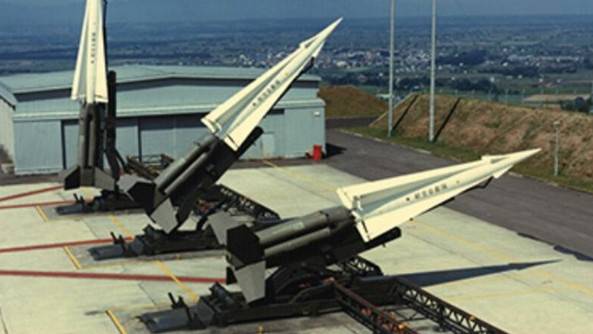
Nike J anti-aircraft missiles in firing position
The rollout of Nike J batteries began in 1971. Five years later, they were equipped with six missile groups (divisions) stationed in the northern, central and southern regions of the country. Most of the complexes were deployed on the islands of Hokkaido and Honshu. In 1976, Japanese airspace was defended by 18 anti-aircraft missile batteries, which included 108 launchers.
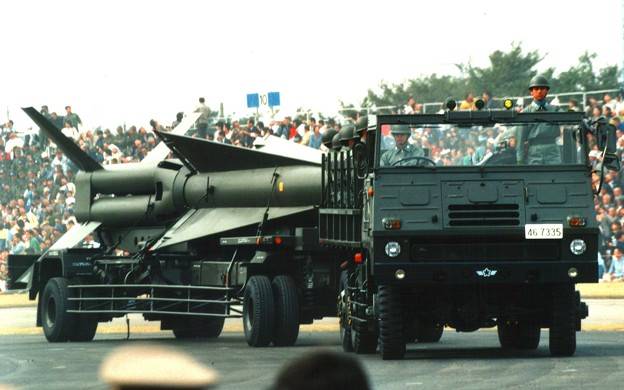
During operation, the Japanese Nike J air defense systems were upgraded twice. The tracking and guidance radars, as well as the calculating device, have undergone improvements. The battery command posts could receive target designation directly from the regional nodes of the Japanese automated air defense system BADGE. At the same time, despite the efforts made, it was not possible to significantly reduce the minimum height of destruction and the accuracy of guidance.
The Research Institute of the Japanese Ministry of Defense TRDI (Technical Research and Development Institute) in the early 1970s, using the Nike J air defense system, developed the TLRM-2 missile defense system.
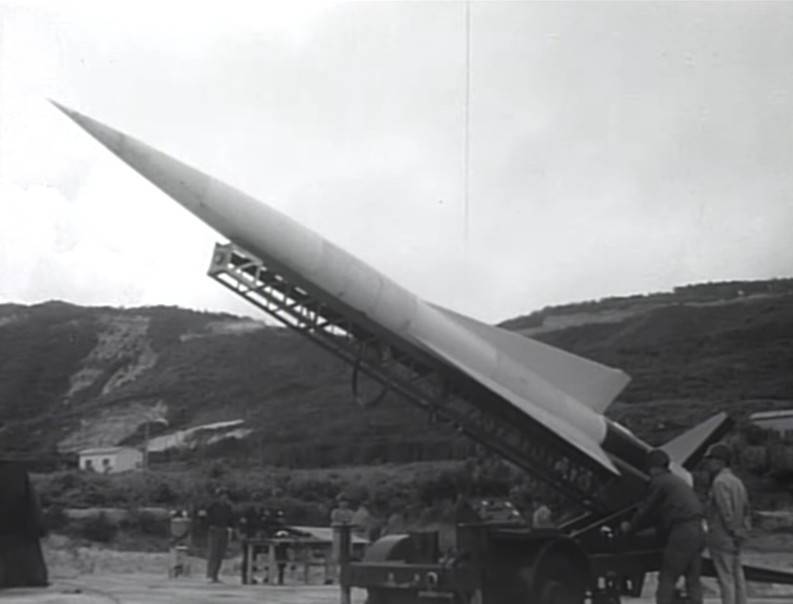
SAM TLRM-2
It was assumed that upon reaching a firing range of about 60 km (the actual firing range of Nike J at small-sized high-speed targets), it would be possible to approximately halve the launch weight and length of the anti-aircraft missile, which, in turn, would allow the use of a towed mobile launcher. However, things did not progress beyond prototypes.
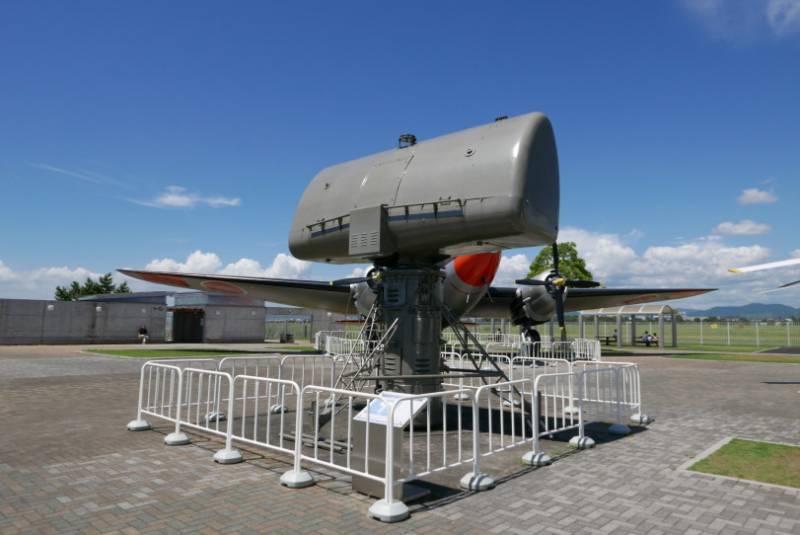
Air target tracking radar for the Nike J air defense system at the memorial complex of the Public Information Center of the Self-Defense Forces in Hamamatsu
Service of the Nike J air defense system in the Japanese Self-Defense Forces ended in 1994. Currently, several anti-aircraft missiles, radar and hardware parts of the complex are exhibited next to the institutions of the Japanese defense department and in museum exhibitions.
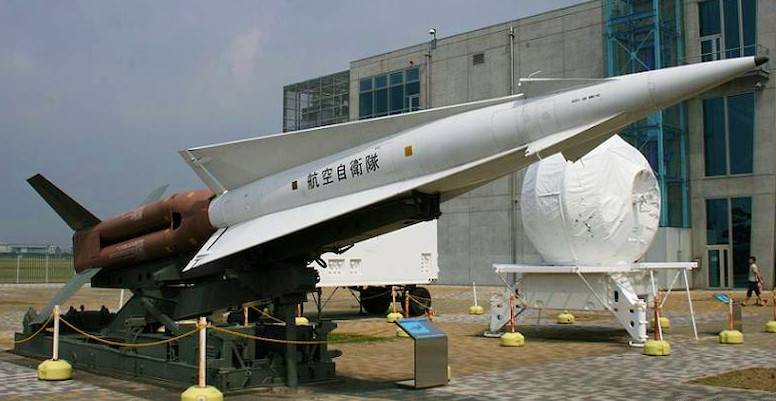
A Nike-J anti-aircraft missile at the memorial complex of the Self-Defense Forces Public Information Center in Hamamatsu. White ball - guidance radar, the trailer contains an analog computing device that calculated the optimal guidance trajectory
Low-altitude anti-aircraft missile system MIM-23 Hawk
Japan became one of the first countries to receive low-altitude air defense systems MIM-23A Hawk. For its time, it was a very advanced mobile anti-aircraft complex with a semi-active radar guidance system. Unlike the actually stationary air defense systems MIM-3A Nike Ajax and MIM-14 Nike Hercules, it could fight high-speed targets operating at low altitudes. The advantages of the complex included: high noise immunity of the illumination and guidance radar, the ability to homing missiles at the source of interference, short reaction time, and high mobility.

Launcher of the Japanese air defense system "Hawk"
The rocket 5080 mm long and 370 mm in diameter had a wingspan of 1210 mm and carried a 54 kg fragmentation warhead. The minimum firing range was 2 km, the maximum - 25 km. The minimum height of the defeat is 60 m, the maximum height of the defeat is 11000 m.
In the late 1960s, Mitsubishi Electric and Toshiba began licensed production of elements of air defense systems and anti-aircraft missiles, which subsequently made it possible to create their own modifications of the American complex.
As of 1975, the Japanese Ground Self-Defense Forces had seven anti-aircraft groups (divisions) of the Hawk air defense system. By 1982, they had all been upgraded to the MIM-23B Improved Hawk. The "Advanced Hawk" could hit supersonic air targets at ranges from 1 to 40 km and in the altitude range of 0,03-18 km.
The main firing unit of the MIM-23V complex was a two-platoon anti-aircraft battery. The fire platoon had a target illumination radar, three launchers with three anti-aircraft guided missiles on each.
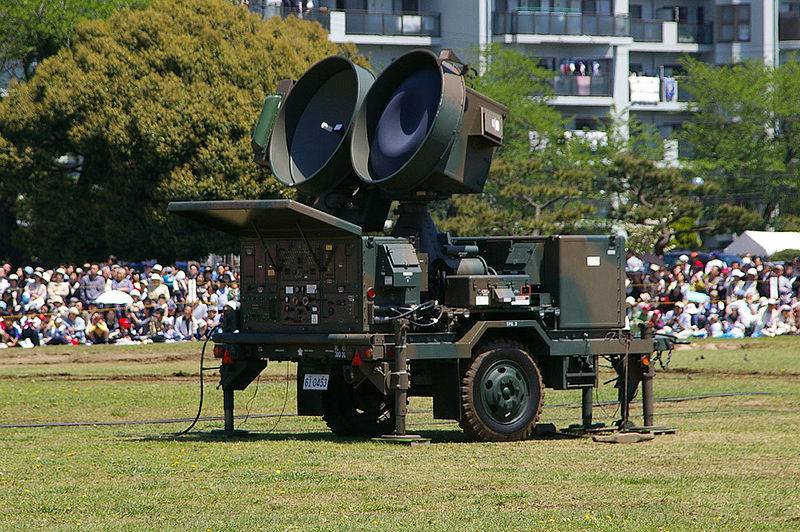
Radar illumination and guidance of the Japanese air defense system "Improved Hawk"
The first fire platoon had a radar for illumination and guidance, an information processing point and a battery command post, and in the second - a control post, a radar for illumination and guidance. Surveillance radar AN / MPQ-50, operating in the frequency range 500 to 1000 MHz, with a pulse power of 450 kW - can detect targets at a distance of 100 km. The AN / MPQ-48 radar is designed to guide the actions of the battery in the near zone and issue target designation to illumination and guidance stations.
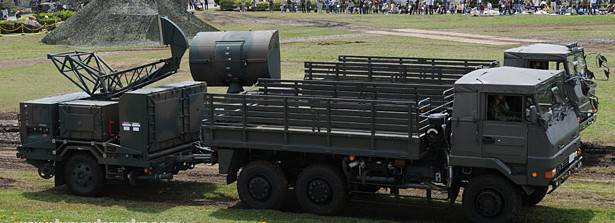
Type 73 trucks towing Type III and Type I radars
In the Hawk Type I modification, which appeared in 1987, a significant part of the American electronic components were replaced by Japanese ones. At the same time, it was possible to increase the resistance of the complex to active interference. On the Hawk Type II modification, the AN / MPQ-50 radar was replaced by the Japanese Type I station, and the AN / MPQ-48 radar was replaced by the Type III station.
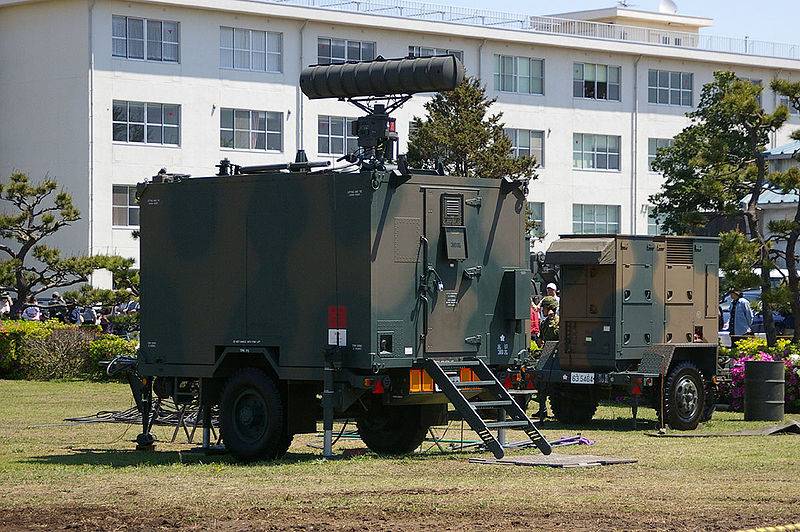
The Hawk Type III modification received a computerized universal command post with its own near-field radar capable of simultaneously seeing several low-altitude targets at a distance of 60 km.
Formally, the Hawk air defense system is still in service with the Japanese Self-Defense Forces, but in fact it has already been almost supplanted by modern Japanese-made self-propelled anti-aircraft systems.
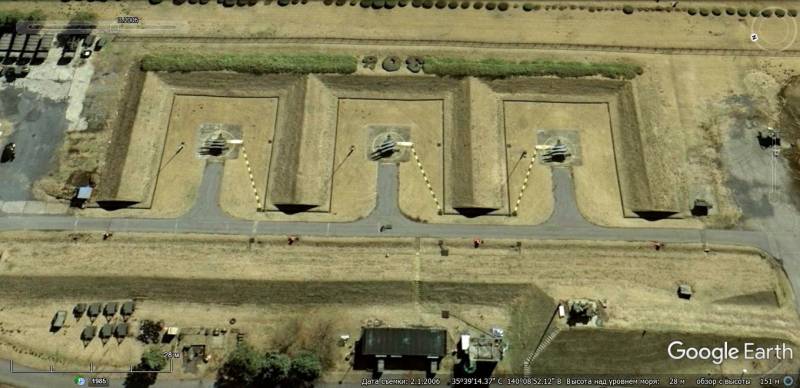
Satellite image of Google Earth: the position of the "Hawk" air defense system at the Shimoshizu military base in Tokyo, 2006
Deployed complexes of this type in 2020 were available in Hokkaido. In other regions of Japan, the surviving Hawk air defense missile systems are no longer on alert and are in storage bases.
Ture 81 short-range mobile air defense system
In the late 1960s, the command of the Ground Self-Defense Forces initiated the development of its own mobile short-range air defense system, which was supposed to replace 75-mm and 40-mm anti-aircraft guns in the troops. The new short-range complex was supposed to fill a niche between MANPADS and medium-range air defense systems and was intended to protect the country's most important civilian objects, military airfields, naval bases, and also for use in military air defense against low-altitude strikes.
In 1978, Kawasaki Heavy Industries and Toshiba Electric presented a complex for testing, which received the working name Tan-SAM. In 1980, the first battery of a mobile air defense system entered trial operation in an air defense unit stationed in the northern part of Hokkaido. After the official adoption, this air defense system was assigned the designation Tour 81.
The complex includes: a command post for its own radar with a phased array and state identification equipment, two self-propelled launchers on the chassis of a Ture 73 all-terrain truck with four missiles on each, a transport and a communications vehicle.
The complex serves 15 people. The combat crew consists of a commander, a detection radar operator and two launcher operators. Launchers can be removed from the command post for 300 m. Communication between them is carried out via cable or radio network.
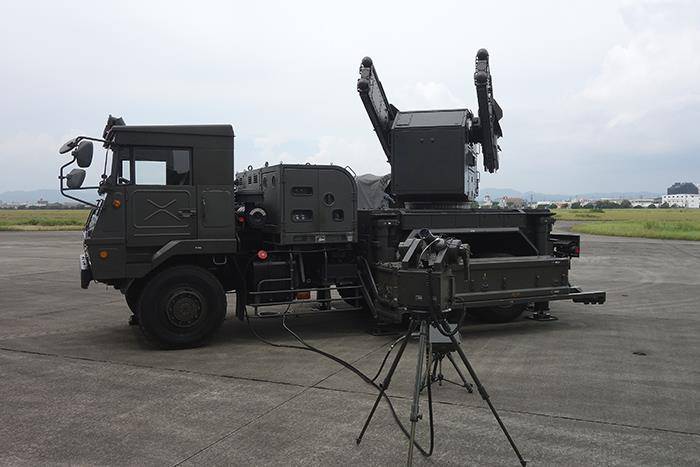
SPU SAM Ture 81 with a remote control panel
Each SPU had its own control panel with an optical sight, which made it possible to fire independently when the control point was out of order.
The deployment time of the complex in a new position is 30 minutes. The elements of the air defense missile system can be dismantled from the vehicle chassis and used permanently or redeployed using CH-47J helicopters.
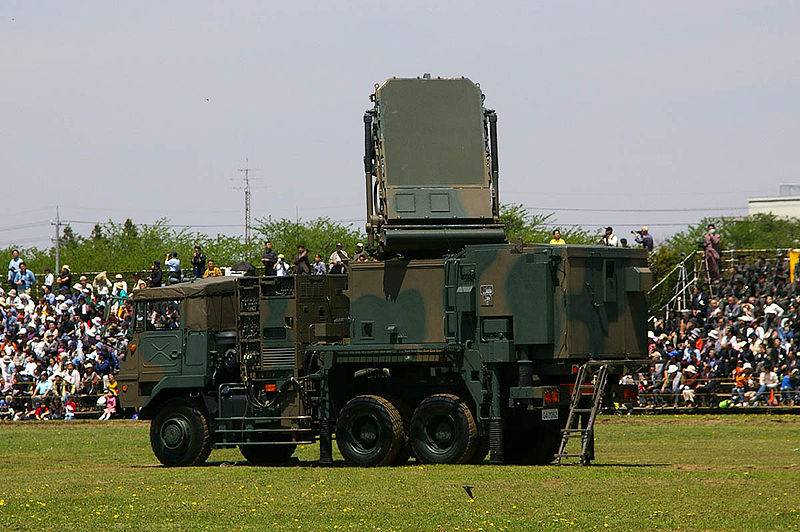
Mobile point of combat control of the SAM Ture 81
The radar detection range of the combat control point on the first modification of the Ture 81 air defense system was 30 km. The rotation speed of the phased antenna is 10 rpm. In one revolution, an area of space is viewed in elevation from 0 to 15 °. In the sector view of the space, the radar scans 110 ° in azimuth, and from 0 to 20 ° in elevation.
Initially, for firing at air targets, only a guided missile with a thermal homing head was used, which had an engagement zone of 500-7000 m, in an altitude range of 15-3000 m.

SAM Tour 81
Rocket length - 2,7 m.Diameter - 16 mm. Wingspan - 600 mm. The launch mass of the rocket is 100 kg, the mass of the fragmentation warhead is 9 kg. The maximum flight speed of the rocket is 780 m / s. A non-contact radio fuse provided a detonation at a miss of 3 m.
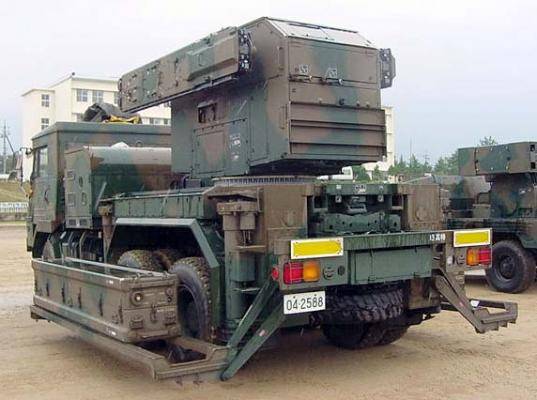
SAM are loaded onto the launcher using two hydraulic platforms located on the sides of the vehicle. The rocket in the transport container is placed on the loading platform, manually removed from the container and installed on the rails. The time for loading the SPU by the crew is 3 minutes.
In total, the Self-Defense Forces received 93 complexes and about 2000 missiles. Subsequently, the Ture 81 air defense system was radically modernized, but this will be discussed in the part devoted to the current state of the Japanese air defense system.
MANPADS FIM-92А Stinger
In 1985, Japan acquired 50 launchers of FIM-92A Stinger portable anti-aircraft missile systems and 400 missiles for them. The American MANPADS was considered as a temporary measure pending the adoption of a Japanese complex of a similar purpose, the development of which had been carried out by Toshiba since 1979.
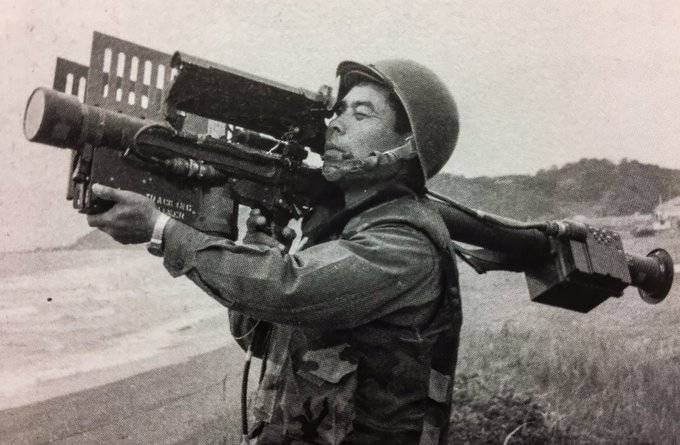
A soldier of the Japanese Self-Defense Forces with FIM-92A Stinger MANPADS
The FIM-92A Stinger MANPADS, used in the Ground Self-Defense Forces, was an early modification, with a simple IR-seeker, the noise immunity of which, when using thermal interference, left much to be desired. The affected area was 500–4500 meters in range and 3500 meters in height. The kit in the firing position weighed 15,7 kg. The length of the rocket is 1500 mm, the diameter of its body is 70 mm, the span of the stabilizers is 91 mm. The maximum rocket speed is 750 m / s.
The Japanese operated the Stingers in ground units until 2009, after which they were replaced by their own Tour 91 MANPADS.
SAM PAC-2 Patriot
In 1989, Japan received the first battery of the PAC-2 Patriot air defense missile system. This mobile complex was purchased to replace the outdated long-range semi-stationary air defense system Nike J.
The PAC-2 Patriot air defense system includes: AN / MPQ-53 multifunctional phased array radar, AN / MSQ-104 fire control point, M901 launchers, MIM-104C anti-aircraft missiles, AN / MSQ-26 power supplies, communication facilities, technological equipment,
means of radio-technical and engineering camouflage.
Multifunctional radar AN / MPQ-53 is mounted on a two-axle semitrailer weighing 15 tons and transported by a wheeled tractor. The operation of the radar is largely automated - it is serviced by two operators.
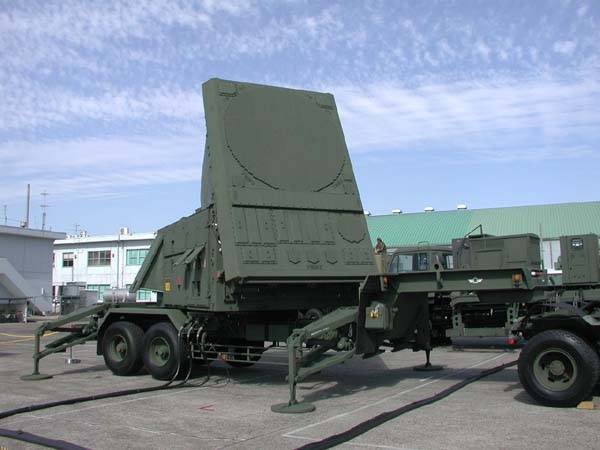
AN / MPQ-53 multipurpose phased array radar of the Japan Air Defense Forces
The station provides in a given sector detection, identification, tracking of up to 125 air objects and flight control of missiles aimed at targets. The maximum target detection range when viewing in elevation from 0 to 90 ° and in azimuth in the 90 ° sector is 35-50 km (at a target flight altitude of 50-100 m) and up to 170 km (1000-10000 m). This is achieved by using a phased antenna array and a high-speed computer that controls the operation modes of the station at all stages.
MIM-104C anti-aircraft missiles are supplied in rectangular aluminum TPK. At the front, the container is closed with a rubber cover reinforced with fiberglass, which is pierced by a rocket at launch, and at the back, with a cover made of hard fiberglass, which is completely removed by gases flowing out of solid propellants.
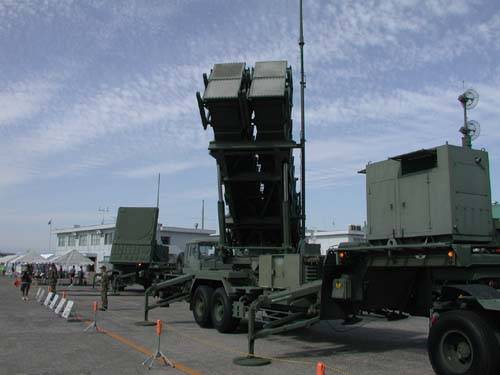
M901 Launcher of the Japanese Air Defense Forces
The flight control of the missile defense system is carried out using a combined guidance system. At the initial stage of the flight, programmed control is implemented, at the middle stage - radio command control, at the final stage - radio command control with sighting through a rocket (radio command guidance of the second kind).
In the process of guiding the missile to the target using the AN / MPQ-53 radar, the target and the ZUP are simultaneously tracked. The radar signals reflected from the target are received by the anti-aircraft missile equipment, and the angular coordinates of the target's line of sight determined by it are transmitted via the HF channel to a special radar antenna and fed to the computer of the fire control point. Also, the computer receives signals received by the radar directly from the target, which are compared with the signals coming from the missile defense system. Based on the analysis performed in the process of comparing these signals, guidance commands for the missile are generated and transmitted to it along the main beam of the radar. After conversion on board the SAM, these commands are transmitted to the rudder control drive, as well as to the anti-aircraft missile antenna drives to ensure continuous target tracking.
In terms of its capabilities to combat air targets, the PAC-2 Patriot air defense system, which used the MIM-104C missile defense system, was comparable to the Soviet S-300PS / PT-1 with the 5V55R missile defense system (firing range 75 km), but at the same time it had limited capabilities. to combat operational-tactical missiles. The Soviet S-300PS / PT-1 complexes were purely anti-aircraft.
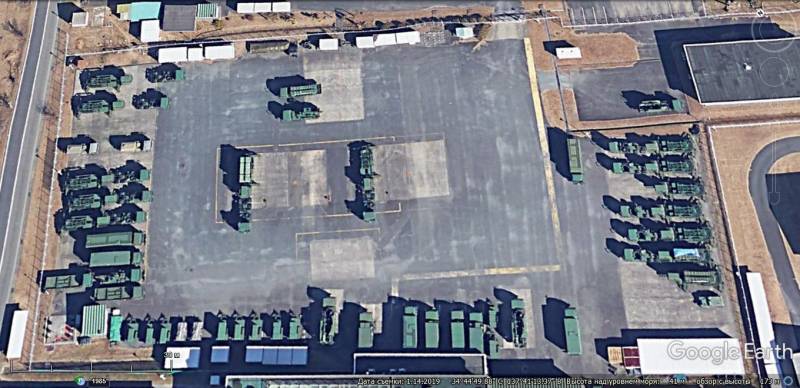
Satellite image of Google Earth: elements of the PAC-2 Patriot air defense system at the Air Self-Defense Force training center in Hamamatsu
The first American-made PAC-2 Patriot long-range air defense system battery was delivered to an air defense training center located in the vicinity of the Hamamatsu air base. At present, this base contains elements of the PAC-2 Patriot air defense missile system, removed from combat duty and in reserve.
The next two batteries were deployed around Naguma in Hokkaido and at Nanjo in Okinawa. Here, these complexes are on alert to this day.
In total, 1996 anti-aircraft groups were deployed in Japan by 6, which included 24 anti-aircraft missile batteries. Each battery in the state relied on 5 launchers with four MIM-104C missiles on each. But in reality, there were usually 3-4 launchers in a combat position.
Продолжение следует ...
- Linnik Sergey
- Actions of American strategic bombers against Japan
Actions of American aviation against the Japanese islands at the final stage of the war
Japanese small-caliber anti-aircraft artillery
Japanese anti-aircraft artillery of medium and large caliber
Single-engine Japanese fighters against long-range American B-29 bombers
Heavy twin-engined Japanese fighters versus American bombers
Japanese post-war anti-aircraft machine gun and artillery mounts
Japan's air defense system during the Cold War
Japanese fighter-interceptors during the Cold War
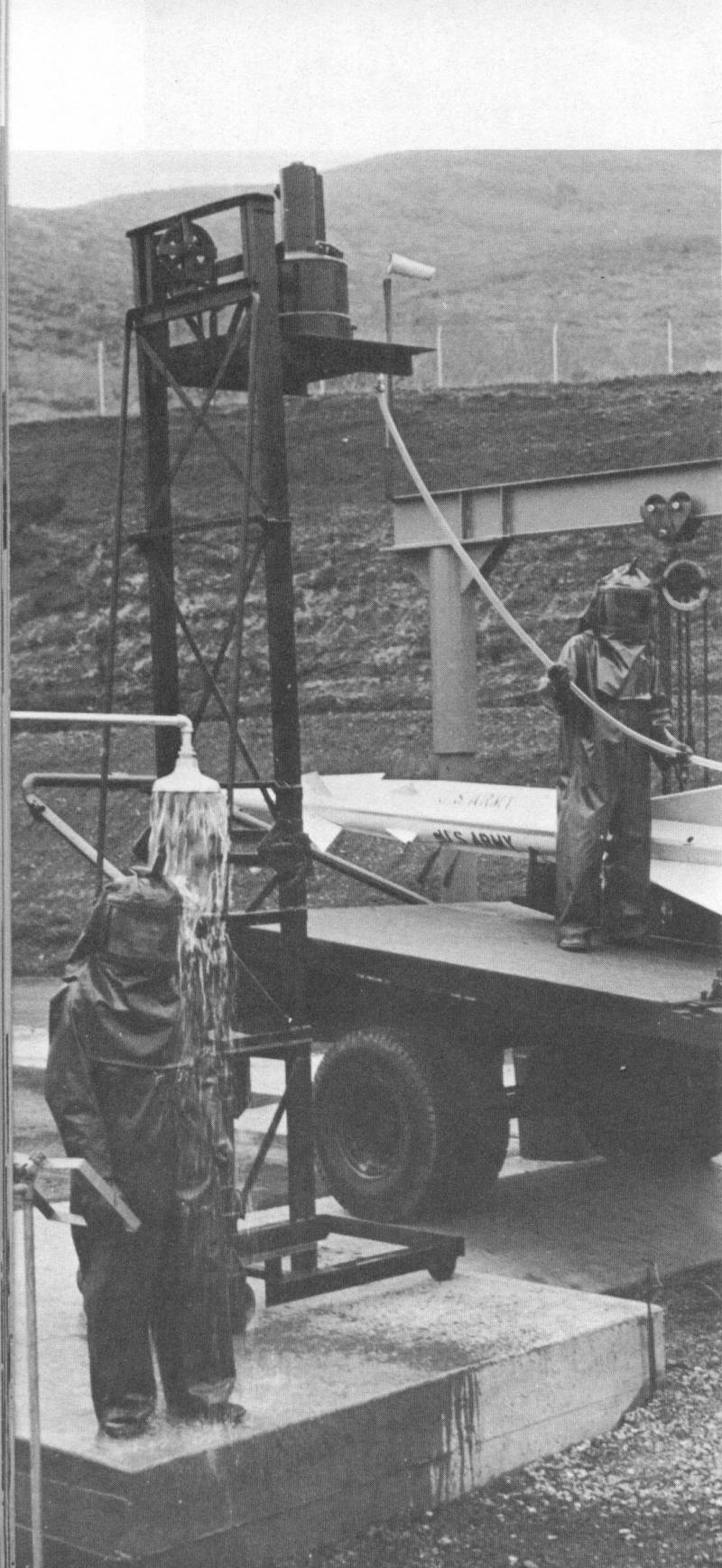
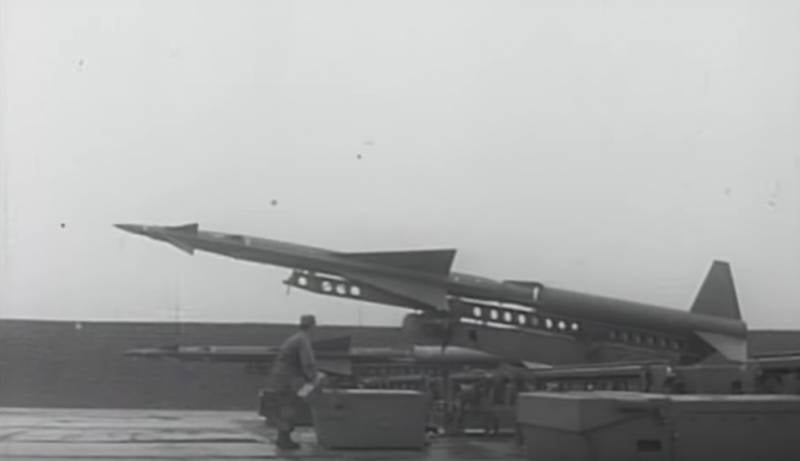
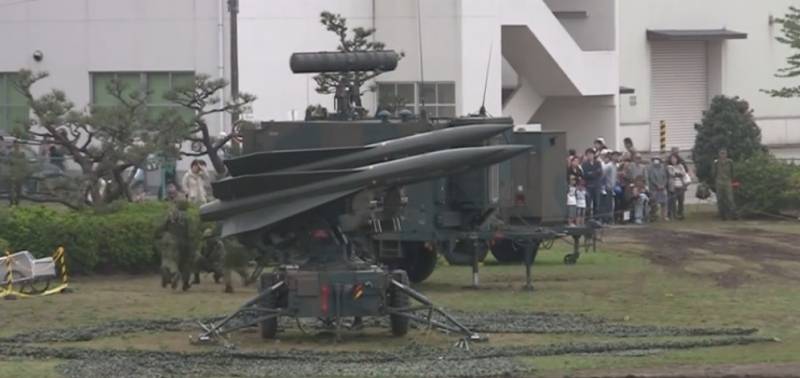

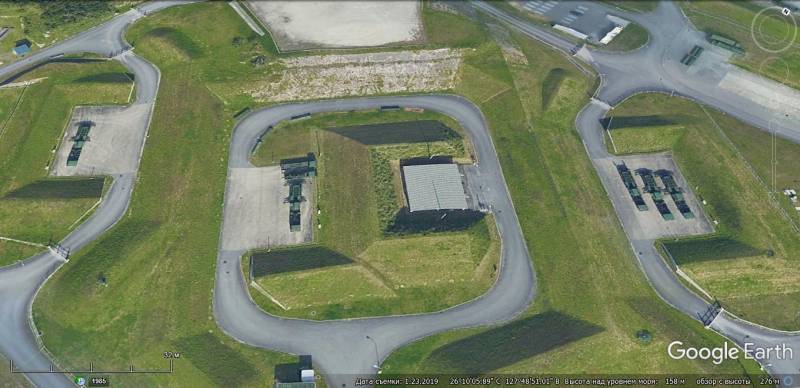
Information